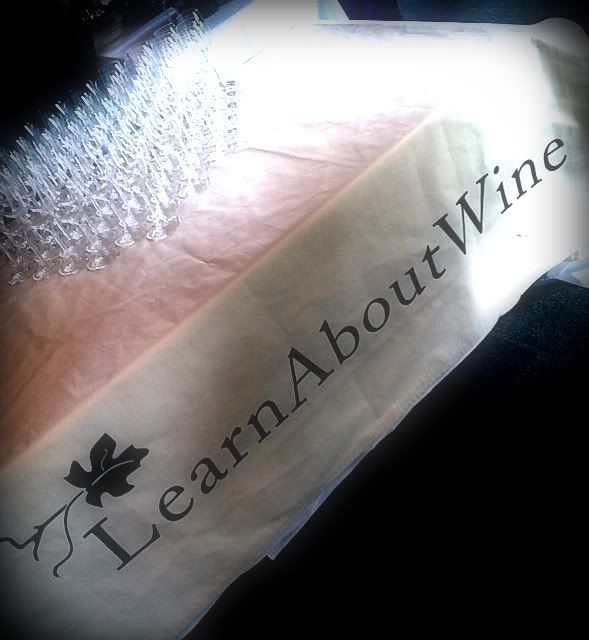
When Paso Robles shows up to pour wine, count me in. The Stars Of Paso Robles event - staged by Southern California's premier wine event outfit, Ian Blackburn's Learn About Wine - featured one great taste after another. I attended the Beverly Hills trade event at McCormick & Schmick's on the afternoon of May 13, 2011. Friday the 13th was never so good.
A roomful of Paso Robles wines meant a roomful of big aromas, big flavors, great acidity and meaty minerals to taste. It also meant a roomful of high alcohol, but that's how it goes in Paso. Every vintage seems to be described as a "spike year."
As I made my way from table to table, it was amazing how many superlative wines were poured. There were plenty of great reds on hand, but in Paso they know how to do whites, too. Every table offered at least two wines which were worthy of mention. I narrowed it down to just those I marked with stars, in the interest of keeping this post from getting out of hand.
Here are my favorites from the Stars Of Paso Robles event:
Adelaida Cellars showed their 2009 Pavanne, a blend of Roussanne, Grenache Blanc and Viognier with great acidity, green apples and minerals.
Alta Colina's Maggie Tillman poured her family's efforts. The reds showed big tannins as a rule, and they rocked. I was most taken with the 2009 12 O'Clock High, a white blend of estate-grown Viognier, Roussanne, Marsanne and Grenache Blanc. Stone fruit and tropical notes are met with honey and minerals and a racy acidity that plays big on the finish.
Bianchi Winery showed a Zinfandel which is lightly tinted and highly expressive on the nose with big black tea aromas and a nice brambly taste. It has an alcohol level of 15.4%, but it doesn't drink like it.
 Cass Vineyard and Winery had a table full of great wines to pour, but partner Ted Plemons was fixated on the big box of Flying Nymph Syrah/Mourvèdre/Grenache which he says is becoming very popular with bars and restaurants due to the high profit margin it offers. That's an 18-liter box inside the display cabinet he had made for it. The fruity wine is tasty, but I liked everything else on the table better.
Cass Vineyard and Winery had a table full of great wines to pour, but partner Ted Plemons was fixated on the big box of Flying Nymph Syrah/Mourvèdre/Grenache which he says is becoming very popular with bars and restaurants due to the high profit margin it offers. That's an 18-liter box inside the display cabinet he had made for it. The fruity wine is tasty, but I liked everything else on the table better.
The Cinquain Cellars table was highlighted by the '07 Syrah which won a gold medal at the San Francisco International Wine Competition a couple of years ago. Coffee and Coke on the nose with spicy dark fruit on the palate bowled me over.
Dubost Ranch winemaker and vineyard manager Zachary Raines had an astounding '07 Zinfandel from the Cushman Vineyard. 40-year-old vines are dry-farmed and tobacco shows up on the nose right through to the amazing port-like finish. When I raised an eyebrow at the 17.2% alcohol number, I was told with a shrug, "It was a hot year." It's still a hot year.
Hammersky Vineyards had some interesting offerings, notably the Cab/Merlot blend with firm tannins and smooth mouthfeel. Table spokesman Brandon described it as the wine "for filet mignon, not T-bone." Their 100% Merlot was a big blast of fruit and smoke.
Joel Peterson of Hope Family Wines poured both his Austin Hope line as well as the Treana label. The Austin Hope Grenache - tons of minerality - and Treana White blend of Marsanne and Viognier - huge tropical - were both excellent. I was really drawn to the new Westside Red Troublemaker, a multi-year vintage with a dark, funky nose and palate and gigantic minerals - all for $20.
JK Wine Company winemaker Justin Kahler poured his '09 Katin Viognier. The grapes are from Paso Robles' Templeton Gap and the 100% varietal wine shows tremendous aromas of honeysuckle and a tempting, flinty salinity from the minerals Paso is famous for.
Niner Wine Estates poured one of my favorites at the event - their 2008 Sangiovese. It's a brand new release with an extremely lush nose featuring flowers, cherries and smoke. The palate shows sour cherry and a fabulous minerality. There's 5% Barbera in the mix.
Roxo Port Cellars is one of my favorite tables at events featuring Paso Robles wines. The chocolatey Cabernet Franc Port and the candy-like Cab/Syrah Port both are astounding, but theTraditional blend of Portuguese varieties moved me. Souzau leads the way instead of Touriga Nacional in the '07 vintage.
Villa Creek Cellars poured their '08 Mas de Maha, a blend of Tempranillo, Grenache, Mourvèdre and Carignan. This wine puts the Paso spin on the Spanish grape, with red fruit on the nose and lots of minerals on the palate. There's a nice herbal profile from the whole-cluster fermentation employed.
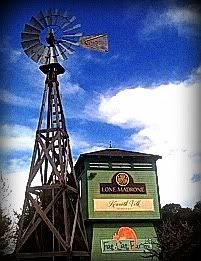
Several years ago at the Ojai Wine Festival I tasted a white blend by Paso Robles producer Lone Madrone that I fell in love with. It's called La Mezcla. The notes of bananas and tropical fruit on the nose, the citrus and minerals on the palate and the zesty acidity made this mix of Grenache Blanc and Albariño an instant favorite of mine.
Lone Madrone's owner and winemaker Neil Collins may be known to you as the Tablas Creek winemaker. Lone Madrone is his personal label.
As long as I was in Paso, I figured I'd better stop in to the tasting room and see what else Collins had to offer.
Lone Madrone's Points West White 2008 has a funky nose and fabulous acidity. A full-feeling wine, it's a blend of Roussanne, Viognier and Picpoul Blanc which displays pears, peaches and a sense of wet rocks on the palate. The '07 Sweet Cheeks is an amazing wine. the grapes are handled in Vin de Paille style, where they are set out on straw in the biodynamic vineyard for a few days after harvest. It has a beautiful, full mouthfeel bursting with apricot nectar.
A dry rosé, the 2010 Zin Blanco is all Zinfandel, showing earthy strawberries for summer. The'09 La Mexcla Roja is great for warm weather, too. It's a bright red wine with a slight effervescence and plenty of earthy minerals. Serve this blend of Grenache, Cinsault, Counoise, Nebbiolo and Zinfandel chilled.
Points West Red 2007 is made of Syrah and Mourvèdre. It has a briar-laced strawberry nose and big red fruit on the palate with a touch of vanilla spice. Barfandel is not a new grape - or a stomach disorder - it's Lone Madrone's blend of Barbera and Zinfandel. White pepper in the bouquet is joined by spicy, brambly red fruit on tha palate.

Numbers from the U.S. Census are cited in a Wine Enthusiast article which shows how Americans are spending their wine dollars.
The numbers say the American public spends $36.3 billion dollars a year on alcoholic beverages.
Women buy more than half of the wine for American households. It's a trend that is gaining momentum over the past few years, particularly in the white, Asian and African-American demographics.
Wine Enthusiast notes that Baby Boomers are being squeezed by other societal segments. Wineries appealing to a Spanish-speaking audience are advertising on Telemundo, while African-Americans are being courted on BET. Millennials are also the target of more advertising dollars.
The magazine says childless singles and single parents are now the second largest wine-buying category, even though single parents tend to earn and spend less. WE figures this will lead to more coverage about the health aspects of wine and more stories on how to stretch the wine dollar farther.
Restaurants are still struggling with recession woes and are looking to wines by the glass rather by the bottle, to help boost revenues, according to the article.
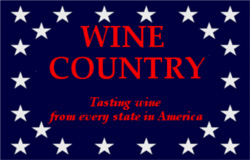
The Now And Zin Wine Country series continues with the wine of Massachusetts. The wine industry in The Bay State is still in its infancy by modern standards, although wine has been produced in Massachusetts since the 1600s. The Pilgrims had barely gotten off the Mayflower when they started making wine from indigenous grapes.
Massachusetts now has over 30 wineries producing over 160,000 gallons of wine per year. Most of the wineries are in the southern portion of the state.
Cape Cod Winery was founded in 1994 by the Lazzari family. The winery is located in the Southeasten New England AVA. In the sandy, gravelly soil of their gently sloping vineyards in East Falmouth, Massachusetts, the Lazzaris grow Cabernet Sauvignon, Cabernet Franc, Merlot and Pinot Grigio grapes. They also grow Seyval and Vidal, and the wine I tasted is a blend of those two white grapes.
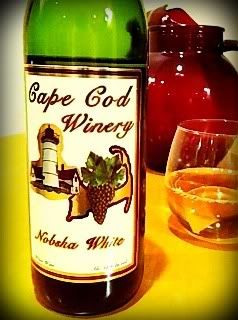 Cape Cod Winery's Nobska White blends Seyval Blanc and Vidal Blanc to produce a semi-sweet white wine with only 12% alcohol content. Both are hybrid grapes, with Seyval ripening early and well suited to cold weather and Vidal noted for its elevated sugar content and high acidity.
Cape Cod Winery's Nobska White blends Seyval Blanc and Vidal Blanc to produce a semi-sweet white wine with only 12% alcohol content. Both are hybrid grapes, with Seyval ripening early and well suited to cold weather and Vidal noted for its elevated sugar content and high acidity.
Nobska White has a beautiful golden color in the glass and is quite aromatic, with a candy-like aroma of guava-meets-cognac. A honey component joins a green pepper scent on the nose as well. The flavor is strongly tropical and finishes like a lemon-lime Sweet Tart. The wine is well suited for pairing with seafood with an acidity level that, while not razor sharp, is crisp and refreshing. The mouthfeel is rather full - it feels almost creamy in the mouth - and should be served chilled for best effect.
I would imagine Cape Cod Winery's Nobska White would be a perfect wine to sip on the deck during warm summertime weather.
Cape Cod Winery also makes two red blends - one of Cabernet Sauvignon and Cabernet Franc and the other a Merlot/Cabernet Franc mix. The winery's blush is created using their Seyval grapes and organic Cape Cod cranberries.
Follow Randy Fuller on Twitter

Paso Robles wine country takes center stage on the sixth episode of the PBS television series Vine Talk, hosted by Stanley Tucci. The series puts Tucci and a panel of celebrities in a loosely formatted setting to taste and talk about wine. It's designed to be an alternative to stuffy wine discussion - the studio audience even gets into the act.
Each week, the series spotlights a different wine region, with a blind tasting and lively banter ensuing. Vine Talk's producers were assisted by the Paso Robles Wine Country Alliance in putting together a sampling of Zinfandels from the region. Episode 106 ofVine Talk features Tucci, FOOD & WINE executive wine editor Ray Isle, celebrity chef Tim Love, former MLB All-Star pitcher Ron Darling and violinist Philippe Quint discussing the Paso Robles Zins they're sampling.
The six wines in question are from Carina Cellars, J Dusi Wines, Peachy Canyon Winery, Steinbeck Vineyards and Winery, Turley Wine Cellars and Victor Hugo Winery.
For more information on Vine Talk, including stations, airtimes and videos from the show, visit the show's website.
"It’s exciting for Paso Robles wines to be highlighted in this show with such incredible personalities," said Christopher Taranto, marketing director of the Paso Robles Wine Country Alliance. "Vine Talk stands to enthrall new wine consumers into discovering Paso Robles and our wines. The timing could not be better as we prepare to celebrate the biggest festival of the year in Paso Robles Wine Country. "
The publicity does come at a great time for Paso Robles, as the 29th Annual Paso Robles Wine Festival is coming May 20 - 22, 2011. The spectacular promises several big events as well as activities at more than 140 Paso wineries throughout the weekend.

If you have yet to check out the website DrinkLocalWine.com, you really should surf by and take a look. The site aims to shed light on the wines of regions other than California, Oregon, Washington. Most wines produced in America come from those three states, but wine is produced in all 50 states, so why not explore the wine produced where you live? Food lovers are doing it with the locavore movement. Why not local wine?
Drink Local Wine is the brainchild of Washington Post wine columnist Dave McIntyre and journalist Jeff Siegel. Their site was featured in an article in WineBusiness.com.
The site has partnered with Texas, Virginia and Missouri on major events promoting the wines in those states and they have another regional conference planned in Colorado.
Now And Zin's Wine Country series is currently attempting to explore wines from all over America, on a somewhat smaller scale.
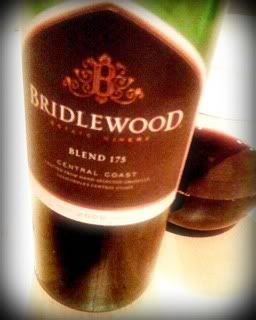
The Bridlewood winery is on the east side of the Santa Ynez Valley, about 30 miles north of Santa Barbara. It’s a white, Mission-style structure with a red tile roof - the kind so popular back down Highway 154 in the Mission city. Bridlewood's winemaker, David Hopkins, has 20 vintages behind him and he works for E & J Gallo, who own Bridlewood The label of Blend 175 states that the wine was bottled at their winery in Healdsburg.
Blend 175 sets a modest alcohol number - just 13% - and I bought it at a grocery store in Los Angeles for $15.
Blend 175 is made up of Syrah, Cabernet Sauvignon and Zinfandel. The winemaking crew tasted through blend after blend after blend, and the 175th blend was the winner. Whether that’s true or apocryphal, I don’t know. It makes a nice paragraph on the label, though.
The wine’s color is medium-dark ruby with some purpling around the edge. Hopkins likes to "follow the fruit," and he certainly does so here. The nose shows a truckload of fruit - blackberry and blueberry - in a straightforward attack on the olfactory. There’s a bit of alcohol upon opening the bottle, and that shows up on the palate as well. I thought that was a bit odd considering the wine carries a reasonable alcohol number.
After it opens up the alcohol burns away and the fruit is gorgeous, dark and lip-smacking with the Syrah showing its spice and the Cabernet letting its graphite speak. Not too much here from the Zin except a very slight hint of brambles coming through. the wine's texture becomes darker on the second and third nights after the bottle was opened.
Film director and wine baron Francis Ford Coppola has undertaken the huge project of trying to breathe life back into the downtrodden Inglenook brand.
A San Francisco Chronicle article in the business section reported that Coppola has acquired the Inglenook name from the Livermore, California-based company The Wine Group. Coppola's Rubicon Estate in Napa Valley is on the actual property which used to be Inglenook. According to the article, he intends to transform the property into America's premier wine estate.
Inglenook enjoyed a three-decade run as one of America's top quality wine producers. That period ended in the mid-1960s when the brand was sold to United Vintners. That started a decline which resulted in the Inglenook label landing in wine's bargain basement alongside Paul Masson, Almaden and Franzia.
Inglenook's current product is looked upon by many as plonk, but Coppola points out that bottles from the company's heyday are still regarded as some of the best Cabernets in the world. His intention is to bring back that kind of quality to the Inglenook name.
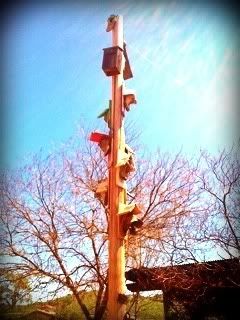
Cass Vineyard and Winery in on the eastside of Paso Robles, in California's Central Coast AVA. They are due east of Templeton Gap, which brings the cool breezes in from the ocean. They do get hot, though, during the day. That's what helps ripen the Rhone grape varieties they grow.
Cass utilizes only estate-grown fruit. The vineyards are all around the tasting room, which I had a chance to visit recently. I didn't go out and literally touch the grapes, but they say you can.
The tasting room is spartan, with a visible, metallic kitchen area where picnic lunches are prepared if you wish to take your meal down a path to an oak-shaded picnic area. There is also seating in the shady front area, near the door of the tasting room. Also just outside the tasting room door is the most unusual birdhouse in the Central Coast (pictured).When Cass says they grow Rhone varietals, they really mean it. From their website:
"A unique feature of our wine making is that all of the Rhone grapes we grow are ENTAV certified. ENTAV (Establissement National Technique pour l’Amelioration de la Viticulture) is the national agency of France responsible for the quality of wine grape varieities. Over 90% of all French Vineyards are started with ENTAV certified plants and are only recently available in California. Consequently, these are among the very first wines made from ENTAV grapes grown here."
It was busy in the tasting room for my visit, with everyone wearing several different hats to accomplish different jobs at once. Here are the wines of Cass winemaker Lood Kotze which were poured for me that day:
Viognier 2009 - All stainless steel, the Viognier is produced using a South African yeast. A somewhat tart nose makes the creaminess in the mouth a bit of a surprise. Nice acidity is doubled on the citrus finish. They tell me the 2010 vintage should have an even rounder mouthfeel.
Roussanne 2009 - Fermented in stainless, this wine is mineral-driven on the nose and palate. Pears and citrus finish with a nutty aftertaste.
Oasis Rosé 2009 - Grenache and Syrah make up most of this blend, but nine varieties in all are used. A touch off-dry, it's got beautiful red fruit from front to finish.
Rockin' One Red 2008 - Syrah, Mourvèdre, Grenache and Petite Sirah make up this heritage wine for Cass - "the one that started it all!" It has a great nose full of red fruit and herbs with a touch of eucalyptus in the flavor profile. It's my favorite from their menu.
Cabernet Sauvignon 2008 - Rich and ripe, this Cab shows silky smooth cassis flavors with a bit of graphite.
A couple of new additions were poured: the '09 Mourvèdre has a nose of chocolate-covered cherry - it's a customer favorite - and the '09 Grenache has a bright cherry nose, wonderful acidity and stirring minerality.
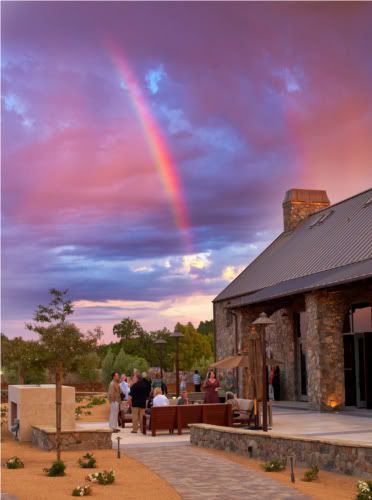
The wine industry boasts many people and companies who would like to make the world a better place. Making great wine for our enjoyment certainly helps in that effort, but there is much more to improving our situation on the planet than knowing how to create a good time in a bottle.
Niner Wine Estates in Paso Robles has gone above and beyond the call of wine, at least according to the U.S. Green Building Council. Niner's state-of-the-art facility has been honored with the organization's LEED Silver Certification. This makes Niner one of only four wineries in California - and the first in the Central Coast AVA - to be recognized in this manner for designing and operating their facility with extreme greenness in mind.
LEED stands for Leadership in Energy and Environmental Design. It's a building rating program, a nationally accepted benchmark for evaluating the design, construction and operation of high performance green buildings. Buildings are certified based on superior performance in energy efficiency, sustainable site development, water efficiency, selection of materials and indoor environmental quality.
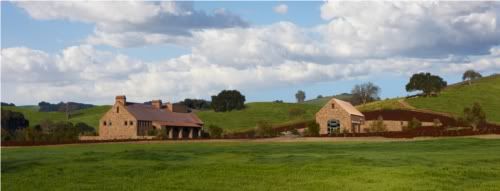 Niner was awarded the LEED Silver Certification for its Paso Robles complex, which includes a Hospitality Center, Demonstration Winery and Production Winery totalling about 75,000 square feet on 140 acres of Westside real estate.
Niner was awarded the LEED Silver Certification for its Paso Robles complex, which includes a Hospitality Center, Demonstration Winery and Production Winery totalling about 75,000 square feet on 140 acres of Westside real estate.
Niner's owners Richard and Pam Niner were over the moon about the certification. According to Rick Fedrizzi, President, CEO and Founding Chair of the U.S. Green Building Council, so was the council. "The work of innovative building projects such as Niner Wine Estates is a fundamental driving force in (the green building) movement," said Fedrizzi.
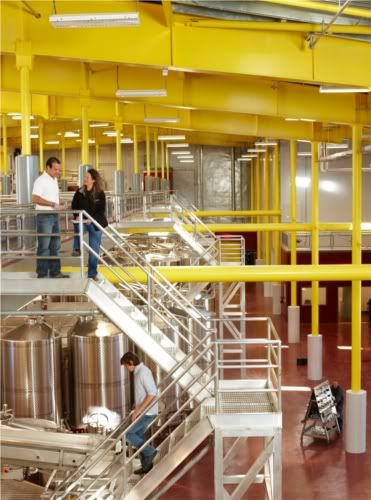 A tour of the facility showed the different facets which allowed Niner to achieve the honor. Niner's enologist, Lorna Kreutz, guided me through the entire Production Winery. She took it all in stride, but I was agog at the pristine conditions I found in the tank room. I guessed that since the place is fairly new, it just hadn't had time to take on a "lived-in" look. "No," said Lorna, "we work pretty hard to keep it looking nice." I spied what looked like a couple of scraps of paper on the floor, but I was wrong again. "Those are actually pieces of tape placed there for measurement purposes," she said. "When the crew is done working, they'll take those up."
A tour of the facility showed the different facets which allowed Niner to achieve the honor. Niner's enologist, Lorna Kreutz, guided me through the entire Production Winery. She took it all in stride, but I was agog at the pristine conditions I found in the tank room. I guessed that since the place is fairly new, it just hadn't had time to take on a "lived-in" look. "No," said Lorna, "we work pretty hard to keep it looking nice." I spied what looked like a couple of scraps of paper on the floor, but I was wrong again. "Those are actually pieces of tape placed there for measurement purposes," she said. "When the crew is done working, they'll take those up."
The building, of course, is not only clean - it's green. It's built into a cut in the hillside to help keep it cool naturally. Insulated concrete walls help with that, too. The cellar has a system which brings in night air, and that also helps reduce cooling needs.
Lorna explained that wastewater is treated and recycled for use as vineyard irrigation, and rainwater is also collected for that purpose.
The building materials are either recycled or locally manufactured, the multi-level design allows gravity to do the work of pumps and even the paint and flooring uses materials which enhance not only the indoor environment, but the one outside as well.
Niner Wine Estates has proven that a technologically advanced facility can also be one that fits well into its surroundings and one that keeps the environment at the forefront. All this comes at some cost. As I poked around various places in Paso Robles, I heard the facility and its "$50 million pricetag" talked about with some pride and, I suspect, some jealousy. I'm sure any winemaker would love to have this kind of winery as a workplace. Niner's winemaker Amanda Cramer should get some of the credit for this design, as she had a hand in creating the Niner winery as a functional wonder of the wine world.
Richard Niner is the visionary here, and he's the guy who put his money where his dreams are. His belief that world class wines are the sum total of great people, great vineyards, great tools and great ideas is the driving force behind Niner Wine Estates.

When you’re tasting a wine at home, it’s always great to be able to pair it with food and find out what it works with, or what it doesn’t.
I often don’t have a nice meal in front of me when I’m evaluating wines, so I end up grabbing a handful of almonds, or fishing an olive out of the jar to have some edible reference point.
Apparently, the folks at Wine Spectator like a little snack food with their wine, too. Wine Spectator School and Triscuit have released the Recipes For Wine Lovers iPhone App. The app allows you to select one of 20 wine-friendly Triscuit recipes. The great wheel of snacks spins around and - clink! - down drops a glass containing just the right wine.
According to the app, for Italian salami and cheese on a Triscuit, select a Cabernet. Hot, sweet, bubbly cheddar on a Triscuit calls for Riesling. Bubbly four-cheese tomato on a Triscuit demands nothing less than Pinot Noir. You get the idea.
If any of the snacks strike your fancy, tap on it and a full screen recipe for that treat appears. Of course, it’s usually not much more instruction than, “take the stuff and put it on a Triscuit, then eat it. With wine."
You can find the Triscuit Small Plates app in the iTunes App Store for free. If you have no iPhone, you access the information by website at the same low price.
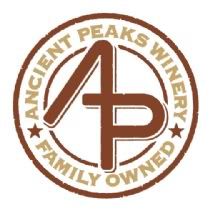
A
trip to Paso Robles, California promised a high level of exposure to people who live and breathe wine. Before my destination arrived, I took the Santa Margarita exit from US Highway 101 and found myself immersed inAncient Peaks Winery.
The Vineyard Tour
It wasn't just a tasting room visit, either. I hopped up into Karl Wittstrom's huge pickup truck and headed for the vineyard, stopping just up the road for a bag of sandwiches to bring along. That's how they do the tour at Ancient Peaks. They get you out of the cozy tasting room and take you where the wine business really happens.
Ancient Peaks is owned as a partnership by three winegrowing families. Karl Wittstrom is one third of that partnership. A towering rancher who knows the vineyards like he knows low gear in that pickup, Wittstrom is a fountain of knowledge about the grapes, the vines, the dirt, the rocks, the mountains, the flora and fauna, the bugs - he knows about everything you can see from any point in his vineyard, and that's a lot. I didn't ask, but I'm sure he could identify every grain of dirt on his dusty floorboard mats.
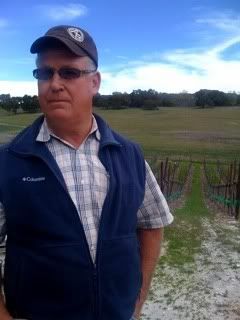 The thing is, you don't have to ask. Karl Wittstrom has all this information ready to spill forth anytime someone looks interested, which I suppose I did.
The thing is, you don't have to ask. Karl Wittstrom has all this information ready to spill forth anytime someone looks interested, which I suppose I did.
His urge to share is so great and his energy so boundless he's the natural choice to guide the tour. At one point he stopped the truck and had me get out to look at a compost station. He turned the mulch with a shovel and stuck his hand in to grab some, so I could see the worms. With boyish enthusiasm he motioned with his head back to the pickup, where my wife was chatting with our companion on the tour. With a complete lack of irony, he asked, "D'ya think she wants to see the worms?" I offered that she could probably skip this lesson, and he continued undaunted, poking the compost with the shovel and explaining how the worms figure into the winegrowing process.
I knew before the tour that there was a lot I didn't know about growing grapes. During the tour, it became increasingly apparent just how much I didn't know.
The People of Ancient Peaks
Wittstrom owns his own family vineyard as well as the partnership vineyards with Ancient Peaks. Doug Filliponi - a longtime local winegrower - oversees all vineyard operations for the winery and Rob Rossi - Ancient Peaks' planning and development guy - is connected in the business side of things.
Mike Sinor - Director of Winemaking - has15 years Central Coast winemaking experience. 2006 was his first full vintage at Ancient Peaks. Amanda Wittstrom-Higgins is the winery's VP of sales and marketing. She's a fifth-generation Paso Robles native.
Growing Grapes
All fruit used by Ancient Peaks comes from their sustainable estate vineyards - SIP certified (Sustainability In Practice) - which allows them to "express the personality of the vineyard."
The different varieties of grapes are allowed to ripen at their own pace.
Vineyard pests are controlled naturally, with a program utilizing boxes as habitats for bats, bluebirds, owls and other predatory birds. No oak trees were removed during the planting of Margarita Vineyard, and wetlands requirements were exceeded.
Margarita Vineyard - sustainably farmed - is the southernmost vineyard in the Paso Robles appellation. It's surrounded by the Santa Lucia mountain range which are the ancient peaks from which the name was taken. It is the only vineyard in the area, and its location in the Santa Margarita Ranch is where grapes were first planted by Franciscan missionaries in 1780.
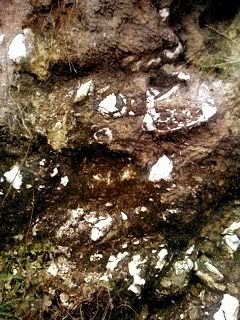 The vineyard features five distinct soil types: ancient sea bed, sedimentary, shale, volcanic and granitic. The folks at Ancient Peaks feel these different soil types bring added dimension and complexity to their wines. Wittstrom delighted in showing off the ancient oyster shells which are imbedded in outcroppings and even scattered about the hillsides of the vineyard.
The vineyard features five distinct soil types: ancient sea bed, sedimentary, shale, volcanic and granitic. The folks at Ancient Peaks feel these different soil types bring added dimension and complexity to their wines. Wittstrom delighted in showing off the ancient oyster shells which are imbedded in outcroppings and even scattered about the hillsides of the vineyard.
Wittstrom concluded the tour by taking us through the rest of the historic Santa Margarita Ranch property dotted with old barns, old things in storage and even an old train built by Walt Disney in 1955. There's history everywhere you look. The train still functions, and they crank it up now and then for special events.
The Wines
Back in the cozy confines of the Ancient Peaks tasting room, we were poured through the wine list. The Ancient Peaks wines are exceptional, each one of them. Most of their wines are in the $14 to $17 price range, with the exception of the Malbec and the Petit Verdot, which sell for $35.
 Sauvignon Blanc 2010 - Grapes from the cool-climate Margarita Vineyard are augmented by a bit of fruit from San Juan Vineyard, in the eastern portion of the Paso Robles AVA. Grass and minerals dominate the expressive nose and the steel-fermented wine is crisp and refreshing with a very nice acidity.
Sauvignon Blanc 2010 - Grapes from the cool-climate Margarita Vineyard are augmented by a bit of fruit from San Juan Vineyard, in the eastern portion of the Paso Robles AVA. Grass and minerals dominate the expressive nose and the steel-fermented wine is crisp and refreshing with a very nice acidity.
Rosé 2010 - Great floral and cherry notes highlight this stainless steel pink made of Pinot Noir from Margarita Vineyard.
Blanco 2010 - Ancient Peaks shows off three of Margarita Vineyard's five soil types in this one.
The Pinot Gris comes from ancient sea bed, the Chardonnay from granitic soil and the Sauvignon Blanc from a sedimentary block. The PG comes on stronger than the Chardonnay, and there's a nice touch of Sauvignon Blanc; minerals galore.
Zinfandel 2008 - Lavendar notes on the nose and a hint of chocolate on the palate make for a delicious experience. The Zin is joined by a splash of Syrah.
Merlot 2009 - This is the variety upon which the brand was founded. Superb minerals play off a cherry/blackberry theme. A bit of help from the Cabs, Sauvignon and Franc.
Cabernet Sauvignon 2009 - Very smooth, and very complex, this Cab has 8% Petit Verdot and 8% Malbec. Cassis and graphite come forward.
Malbec 2008 - One of my favorites here, this wine features a fantastic nose showing traces of violets and chocolate. 8% Syrah.
Petit Verdot 2008 - This 100% varietal wine utilizes grapes from Margarita Vineyard and the warmer climate Wittstrom Vineyard northwest of Paso Robles. It's dark and complicated, with cassis aromas paving the way for a smooth and juicy palate.
Petite Sirah 2008 - The 85% Petite Sirah comes from Karl's personal Wittstrom Vineyard, while 15% is Margarita Vineyard Syrah. A brambly bouquet leads to a dark palate with firm tannins and a caramel finish. This wine carries a 15.7% alcohol number.
Oyster Ridge 2007 - Much of the fruit for this beauty comes from the section of Margarita Vineyard known as Oyster Ridge, the ancient sea bed. Cabernet Sauvignon takes its cues from Petite Sirah, Merlot and Petit Verdot. The nose is big, fruity and floral while the palate shows plenty of minerals. One taste brings the sight of all those oyster fossils into clear focus.

An article in Indiana's Herald Bulletin reveals that Indiana legislators are trying to find new ways to help the Hoosier State's growing wine industry.
When the Indiana Wine Grape Council was created in 1989, it had only nine wineries on the books. Today, Indiana boasts more than 50 wineries in the north and south parts of the state.
The Grape Wine Council says Indiana wineries get 800,000 visitors each year, with the Indiana wine industry adding $33 million to the state's economy.
Indiana wine is seen as a huge benefit for the rural areas where most of the wineries are.
A bill has been introduced which would increase the number of festival permits allowing wineries to serve and sell wine, and it would call on the Indiana Alcohol and Tobacco Commission to study how other states bolster their wine industries.
It may not seem like a very large step, but Indiana, like many states, still has antiquated laws on the books affecting the sale of wine - laws that were put there after Prohibition. Even an Indiana ban on selling wine on Sundays - a law put on the books in 1816 - is still in effect today.
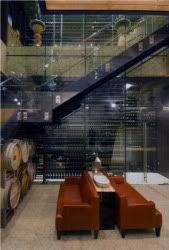
The second annual Stars Of Paso Robles event will be staged twice in Southern California, so wine lovers in Los Angeles and Orange counties will both have access to the pleasures of Paso.
Thursday May 12, 2011 is the date for the Costa Mesa version, while the Beverly Hills soirée is set for the following night, Friday May 13, 2011.
The Costa Mesa event will be held at Charlie Palmer at Bloomingdale's South Coast Plaza. This is fitting, in that the restaurant is themed around wine. The floor is even made from reclaimed wine barrels.
In Beverly Hills, the event will be held outdoors on the cobblestones of the Via Rodeo shopping street at Two Rodeo Drive.
Both wine tasting events will run from 7:00 to 9:30 p.m. on their respective nights and tickets are available for $80 in advance, $150 at the door.
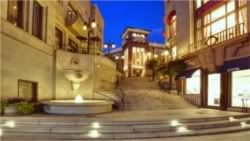 Over two dozen wineries of the Paso Robles AVA are expected to turn out. Names like Cass, Terry Hoage, Hope Family Wines, Turley, Niner and Villa Creek will be joined by hidden gems Roxo Port, Lone Madrone, Alta Colina and Bodegas Paso Robles.
Over two dozen wineries of the Paso Robles AVA are expected to turn out. Names like Cass, Terry Hoage, Hope Family Wines, Turley, Niner and Villa Creek will be joined by hidden gems Roxo Port, Lone Madrone, Alta Colina and Bodegas Paso Robles.
Both events are presented by Learn About Wine, a group dedicated to the appreciation of fine wine and headed up by Ian Blackburn. LAW's Taste and Vintage members receive a discount on tickets.
If you have yet to enjoy an Ian Blackburn wine tasting event, there's no point in waiting any longer. Blackburn is one of Southern California's leading wine educators. He puts winemakers and wine lovers together in an upscale environment and lets the wine do the rest. Always dressed impress, he'll be on hand - as usual - if you'd like to stop and share your thoughts on the wines you are tasting.
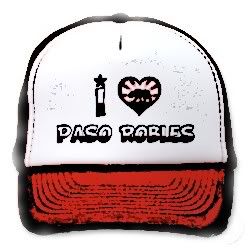
Paso Robles, California is remembered by many as the place actor James Dean had hoped to drive through on his way to Salinas. Dean's life ended 25 miles short of Highway 101 when his speeding sports car collided with Donald Turnupseed's Ford.
Today, that event - monumental at the time - is a footnote in the history of a city which is the center of the fifth largest wine region in California. The Paso Robles AVA comprises two thirds of the Central Coast AVA which contains it. Well over 200 wineries call Paso Robles home, and the number seems to grow every time you check. That fateful intersection of Highways 41 and 46 is memorialized for the legendary car crash which took place there, but in Paso, it's all about the wine.
The Grapes
Paso Robles is most noted for Zinfandel grapes and the wines produced from them, but despite all the festivals held in its honor, Zin actually accounts for only nine percent of the grapes grown there. Cabernet Sauvignon and Merlot cover over half of the pie chart for Paso Robles grape varieties in the AVA's 29,000 acres of vineyards. Over $650 million worth of wine is produced annually in the Paso Robles AVA.
The Layout
Paso - just call it that if you want to sound local - is situated about a half hour north of San Luis Obispo on U.S. Highway 101. The area around Paso Robles is roughly divided into East and West sides, with the freeway as the dividing line. It would be hard to get around in the city and its environs without noticing the wine industry. No matter where you are in Paso, you're near a winery.
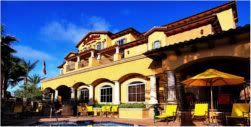 Where To Stay
Where To Stay
If you plan to visit, you are one of 1.2 million tourists who do so each year for Paso wine. There are plenty of hotels, bed & breakfasts and vacation rentals to choose from. I received complimentary lodging at La Bellasera Hotel and Suites for the purpose of this series of articles, and it came highly recommended by everyone I spoke with before the trip. I found it much to my liking, too, and with room rates starting under the $200 mark, I'll check with them first on my next visit.
La Bellasera's Director of Sales Baxter Boyington told me there are over 1250 hotel rooms in Paso Robles. He sang the praises not only of his hotel, but of life in Paso, too. He said returning to his stomping grounds was a distinct pleasure.
As Boyington showed me around the property it was apparent that it's not a huge hotel, but the rooms are clean and outfitted in comfortable elegance, with attention to detail. There are even suites with kitchenettes if your stay is an extended one. A big television in my room never got turned on - no time for TV - but the free WiFi is a must nowadays. A spa and a fitness room offer amenities for those who wish to take a break from wine for a while.
The restaurant at La Bellasera, Enoteca, is appropriately wine-themed and was also on every must-try list I acquired from locals. Steamed clams and mussels are a treat that's hard to pass, and the menu has a number of seafood options, veal, lamb, pork and Angus beef. If you only have time for dessert, try the country style cheesecake or gingerbread creme brulée.
The bar at Enoteca is a favorite hangout for wine people of all stripes. I made new wine friends there, and I'd bet that you will, too - the people in Paso Robles are very friendly. Of course, the wine list at Enoteca is Paso-centric.
Where's The Wine?
As I mentioned, wine is everywhere in Paso Robles. Wineries and tasting rooms abound on the eastside and the west, all the way to the coast. Paso's downtown square just west of the 101 freeway features a number of tasting - and dining - opportunities within easy walking distance.
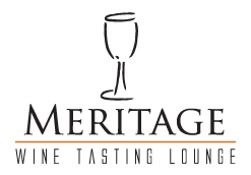 One tasting room is interesting in that it serves as a tasting room for six of the smaller local wineries. TheMeritage Wine Tasting Lounge has a large room lined with tasting bars. The night I visited, only four of the winery spaces were staffed, but on weekends you'll find all six wineries represented.
One tasting room is interesting in that it serves as a tasting room for six of the smaller local wineries. TheMeritage Wine Tasting Lounge has a large room lined with tasting bars. The night I visited, only four of the winery spaces were staffed, but on weekends you'll find all six wineries represented.
Meritage hosts Roxo Port Cellars, Line Shack Wine,Brochelle Vineyards, Cerro Prieto, Michaud Vineyardand JK Wine Company, home of the Arada and Katinlabels. When you check in at the front desk you are handed a card which you use at the tasting bars. You can taste a flight or single wines at each of the stations, then settle up at the desk on your way out.
Brochelle Vineyards had a flight of three wines which could be paired with cheeses. I tasted their Grenache/Syrah/Zinfandel Rosé made from estate fruit. The Jolly Rancher nose and candylike finish has citrus notes and clove in the middle. The Estate Zinfandel sports black cherry and licorice, while their Napa Cabernet Sauvignon is dark and rich, sourced from Mt. Veeder.
Michaud Vineyard poured three wines made from Chalone grapes in Monterey County. The Chardonnay, Pinot Noir and Syrah all bing a lot to the table.
The Arada Las Ramblas Blanca is a blend of Central Coast Chardonnay, Viognier, Grenache Blanc and Albarino. It has a full mouthfeel and crisp acidity that's really refreshing.
I saved Roxo's Port-style wine for last. This producer has been a favorite of mine when I have encountered them at tasting events. Their 2007 Negrette shows flavors of black figs and raisins. Pairing it with chocolate brought the spice notes to the forefront.
Speaking of chocolate, right down the street from The Meritage there’s a great candy store,Powell’s Sweet Shoppe, where I had the most enormous peanut butter cup known to mankind.
I hope you'll keep checking in to the Now And Zin Wine Blog for more articles about the wines and the people I encountered in Paso Robles.
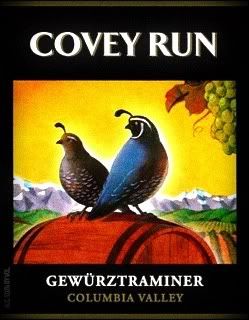
For spicy Asian food, I generally like to call for the Gewürztraminer. I also like it with duck, smoked salmon and cheeses, but its true calling seems to be as a mate for spicy foods. A recent visit to P.F. Chang's China Bistro in the Beverly Center in Los Angeles found me with a glass of a Washington State Gewürz in front of me, from Covey Run.
The Covey Run website states that they use "grapes grown in the Columbia and Yakima valleys, Washington State’s finest growing regions." For this Gewürztraminer, they continue, "Our Gewürztraminer vineyards are located in the cooler parts of Washington’s Yakima Valley, planted at higher elevations and even on northerly facing slopes. Gewürztraminer grown in these areas attains high sugar levels, spicy flavors and a lovely red skin color at harvest, much as it does in its native Alsace."
The 2008 vintage is 100% Columbia Valley AVA Gewurztraminer - earlier vintages featured slight traces of Muscat Canelli or Muscat Ottonel. The floral, fruity nose is immediately inviting, and flavors of peach and pear are joined by a good minerality and light acidity.
The wine paired reasonably well with the fried string beans but really showed its worth with the very spicy pork ribs.
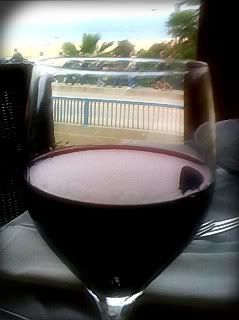
The Santa Monica restaurant called The Lobster is one of my favorite places for lunch in Southern California. The view looking out into the Pacific Ocean and over the Santa Monica Pier are reason enough, but the food's pretty good, too - and that's the understatement of the year.
I never seem to order lobster at its namesake eatery, largely because Denise generally does the honors in the crustacean department and I am always awarded a choice morsel or two from her plate - as long as I've been a good boy.
It can be rather cool along the beach, too, unless it's the heat of summer. Sometimes that cool ocean breeze puts me more in the mood for a red wine. Then, I look for a meal more suited for that choice.
The wine that caught my eye this time was a Garnacha from the San Alejandro vineyard in Calatayud, in the province of Zaragoza, Aragon, Spain. The Las Rocas Vinas Viejas is a rich ruby color with a big, jammy nose full of tar and black fruit. It doesn't taste as brooding as it smells, with strident blackberry and cassis flavors. It's $10 by the glass at The Lobster.
This wine paired perfectly with Tasmanian trout salmon in a Port reduction sauce on creamy polenta with browned Brussels sprouts.
For dessert, a little of Denise's lobster.
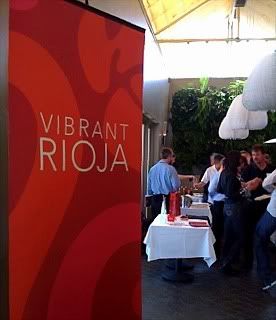
I wrote earlier about the Vibrant Rioja tasting event in Los Angeles, focusing on the Lopez de Heredia wines. Here are some of the other taste treats I discovered at the tasting.
Faustino had two wines I liked a lot. The Crianza '07 andReserva Cinco 2005 both show dense dark noses with earthy fruit. They taste just as rich as the nose leads me to believe they will. The Faustino Gran Reserva '98 is aging well and showing a trace of eucalyptus.
Big flavors came from the Beronia table. The '07 Tempranillo (100%), '07 Crianza of Tempranillo and Garnacha and the '06 Reserva of Tempranillo and Graciano offer big, mineral-driven cherry flavors. The '01 Gran Reserva shows more depth, having been aged three years in barrels and three years in bottles. It blends Tempranillo, Graciano and Mazuelo. Beronia's III a.C. '04 is described as a "Super Rioja," blending Tempranillo, Graciano and Mazuelo grapes. Pepper, leather and tobacco notes adorn the cherry fruit.
Antano's '09 Viura was one of my favorites, a nutty white with great acidity. The Conde de Valdemar Rosé impresses me quite a bit - one of the better $6 wines I've tried. CdV Inspiracion Valdemar 2007 shows a lovely bright cherry flavor. It's 100% Graciano.
Bodeagas Landaluce poured some great wines, in particular the Tempranillo with the mocha nose and the Capricho de Landaluce '05. The latter is all smokey and lush, and it's one of the more expensive wines at the event, with a $47 price tag.
Castillo Labastida's '08 Madurado is rustic and full of minerals, while their Reserva 2004 gives a nose and palate full of succulent black cherry.
Navarrsotillo's Noemus Rioja Blanco '09 makes a huge tropical play, Noemus Rioja Rosado '09 is a 100% Garnacha rosé and the Noemus Rioja Tinto '08 blends Tempranillo with Garnacha and Mazuelo. It has a huge fruit expression. All three of those wines deliver a lot for under $10 each. Spend a little more - $19 - for the Magister Bibendi Rioja Reserva 2005 and you get a great red wine with fantastic tannins and no bite.
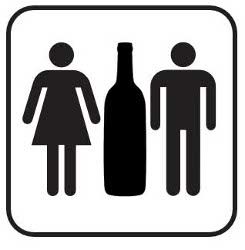
From Natalie MacLean's wine site, NatDecants, comes an article by Bill Ward in which he explores some of the differences between male and female behavior where wine is concerned.
Ward looks at wine through the eyes of both sexes, highlighting the often opposite attitudes on wine.
He quotes Ms. MacLean on how men and women approach wine. "Men are far more focused on the scores," she says, "and women on the stories behind the wines."
Wine merchant Kristen Kowalski supports that claim. She says men typically ask to purchase wines based on the scores they receive from wine critics, while women tend to ask about wines they've seen paired with a particular recipe or wines with which they have personal experience with, say, in a restaurant.
Ward also points out that women are much more likely than men to seek help when selecting a wine in a store or restaurant. Men prefer to do it on their own, even when they don't know what they are talking about. The article cites a British study which found that men tend to claim more knowledge about wine than they actually have.
Kowalski also offers that "Men seem to find a comfort zone and stay in it." She says men tend to be intimidated by imported wines where they may have trouble understanding the information on the labels.
Another retailer says when men find a wine they like, they are more apt to buy a case of it, while women seem to prefer buying mixed cases that offer more variety.
Men and women may look at wine differently, but one thing stays the same between the sexes - wine is definitely a pleasure.
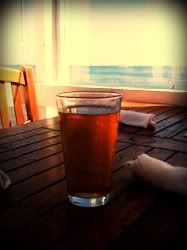
The calendar did not reflect it, but the weather didn't notice on a recent trip to The Beachcomber on the Malibu Pier. It looked and felt like summer to me, and I enjoyed a couple of summery beverages during a long lunch with the mom-in-law. Some may quip that lunch with a mother-in-law is always long, but she and I always get along just fine.
Kona Brewing Company's Longboard Island Lager got things off to a great start. It's really yellow, with a nice head, white and fluffy. The taste is very clean and the hops are fresh with a touch of malt and a citrus edge on the palate.
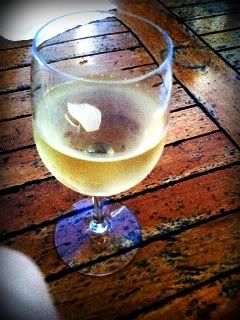 Service was quite slow, so another beverage seemed appropriate. I opted for an Edna Valley white wine I know and love, the Tangent Sauvignon Blanc. Grassy minerals and a nose full of citrus notes lead to a palate loaded with lemon zest and wet rocks. It pairs extremely well with sunshine and Mahi Mahi.
Service was quite slow, so another beverage seemed appropriate. I opted for an Edna Valley white wine I know and love, the Tangent Sauvignon Blanc. Grassy minerals and a nose full of citrus notes lead to a palate loaded with lemon zest and wet rocks. It pairs extremely well with sunshine and Mahi Mahi.
 Cass Vineyard and Winery had a table full of great wines to pour, but partner Ted Plemons was fixated on the big box of Flying Nymph Syrah/Mourvèdre/Grenache which he says is becoming very popular with bars and restaurants due to the high profit margin it offers. That's an 18-liter box inside the display cabinet he had made for it. The fruity wine is tasty, but I liked everything else on the table better.
Cass Vineyard and Winery had a table full of great wines to pour, but partner Ted Plemons was fixated on the big box of Flying Nymph Syrah/Mourvèdre/Grenache which he says is becoming very popular with bars and restaurants due to the high profit margin it offers. That's an 18-liter box inside the display cabinet he had made for it. The fruity wine is tasty, but I liked everything else on the table better. Cass Vineyard and Winery had a table full of great wines to pour, but partner Ted Plemons was fixated on the big box of Flying Nymph Syrah/Mourvèdre/Grenache which he says is becoming very popular with bars and restaurants due to the high profit margin it offers. That's an 18-liter box inside the display cabinet he had made for it. The fruity wine is tasty, but I liked everything else on the table better.
Cass Vineyard and Winery had a table full of great wines to pour, but partner Ted Plemons was fixated on the big box of Flying Nymph Syrah/Mourvèdre/Grenache which he says is becoming very popular with bars and restaurants due to the high profit margin it offers. That's an 18-liter box inside the display cabinet he had made for it. The fruity wine is tasty, but I liked everything else on the table better.



 Cape Cod Winery's Nobska White blends Seyval Blanc and Vidal Blanc to produce a semi-sweet white wine with only 12% alcohol content. Both are hybrid grapes, with Seyval ripening early and well suited to cold weather and Vidal noted for its elevated sugar content and high acidity.
Cape Cod Winery's Nobska White blends Seyval Blanc and Vidal Blanc to produce a semi-sweet white wine with only 12% alcohol content. Both are hybrid grapes, with Seyval ripening early and well suited to cold weather and Vidal noted for its elevated sugar content and high acidity.




 Niner was awarded the LEED Silver Certification for its Paso Robles complex, which includes a Hospitality Center, Demonstration Winery and Production Winery totalling about 75,000 square feet on 140 acres of Westside real estate.
Niner was awarded the LEED Silver Certification for its Paso Robles complex, which includes a Hospitality Center, Demonstration Winery and Production Winery totalling about 75,000 square feet on 140 acres of Westside real estate. A tour of the facility showed the different facets which allowed Niner to achieve the honor. Niner's enologist, Lorna Kreutz, guided me through the entire Production Winery. She took it all in stride, but I was agog at the pristine conditions I found in the tank room. I guessed that since the place is fairly new, it just hadn't had time to take on a "lived-in" look. "No," said Lorna, "we work pretty hard to keep it looking nice." I spied what looked like a couple of scraps of paper on the floor, but I was wrong again. "Those are actually pieces of tape placed there for measurement purposes," she said. "When the crew is done working, they'll take those up."
A tour of the facility showed the different facets which allowed Niner to achieve the honor. Niner's enologist, Lorna Kreutz, guided me through the entire Production Winery. She took it all in stride, but I was agog at the pristine conditions I found in the tank room. I guessed that since the place is fairly new, it just hadn't had time to take on a "lived-in" look. "No," said Lorna, "we work pretty hard to keep it looking nice." I spied what looked like a couple of scraps of paper on the floor, but I was wrong again. "Those are actually pieces of tape placed there for measurement purposes," she said. "When the crew is done working, they'll take those up."

 The thing is, you don't have to ask. Karl Wittstrom has all this information ready to spill forth anytime someone looks interested, which I suppose I did.
The thing is, you don't have to ask. Karl Wittstrom has all this information ready to spill forth anytime someone looks interested, which I suppose I did. The vineyard features five distinct soil types: ancient sea bed, sedimentary, shale, volcanic and granitic. The folks at Ancient Peaks feel these different soil types bring added dimension and complexity to their wines. Wittstrom delighted in showing off the ancient oyster shells which are imbedded in outcroppings and even scattered about the hillsides of the vineyard.
The vineyard features five distinct soil types: ancient sea bed, sedimentary, shale, volcanic and granitic. The folks at Ancient Peaks feel these different soil types bring added dimension and complexity to their wines. Wittstrom delighted in showing off the ancient oyster shells which are imbedded in outcroppings and even scattered about the hillsides of the vineyard. Sauvignon Blanc 2010 - Grapes from the cool-climate Margarita Vineyard are augmented by a bit of fruit from San Juan Vineyard, in the eastern portion of the Paso Robles AVA. Grass and minerals dominate the expressive nose and the steel-fermented wine is crisp and refreshing with a very nice acidity.
Sauvignon Blanc 2010 - Grapes from the cool-climate Margarita Vineyard are augmented by a bit of fruit from San Juan Vineyard, in the eastern portion of the Paso Robles AVA. Grass and minerals dominate the expressive nose and the steel-fermented wine is crisp and refreshing with a very nice acidity.

 Over two dozen wineries of the Paso Robles AVA are expected to turn out. Names like Cass, Terry Hoage, Hope Family Wines, Turley, Niner and Villa Creek will be joined by hidden gems Roxo Port, Lone Madrone, Alta Colina and Bodegas Paso Robles.
Over two dozen wineries of the Paso Robles AVA are expected to turn out. Names like Cass, Terry Hoage, Hope Family Wines, Turley, Niner and Villa Creek will be joined by hidden gems Roxo Port, Lone Madrone, Alta Colina and Bodegas Paso Robles.
 Where To Stay
Where To Stay One tasting room is interesting in that it serves as a tasting room for six of the smaller local wineries. The
One tasting room is interesting in that it serves as a tasting room for six of the smaller local wineries. The




 Service was quite slow, so another beverage seemed appropriate. I opted for an Edna Valley white wine I know and love, the
Service was quite slow, so another beverage seemed appropriate. I opted for an Edna Valley white wine I know and love, the